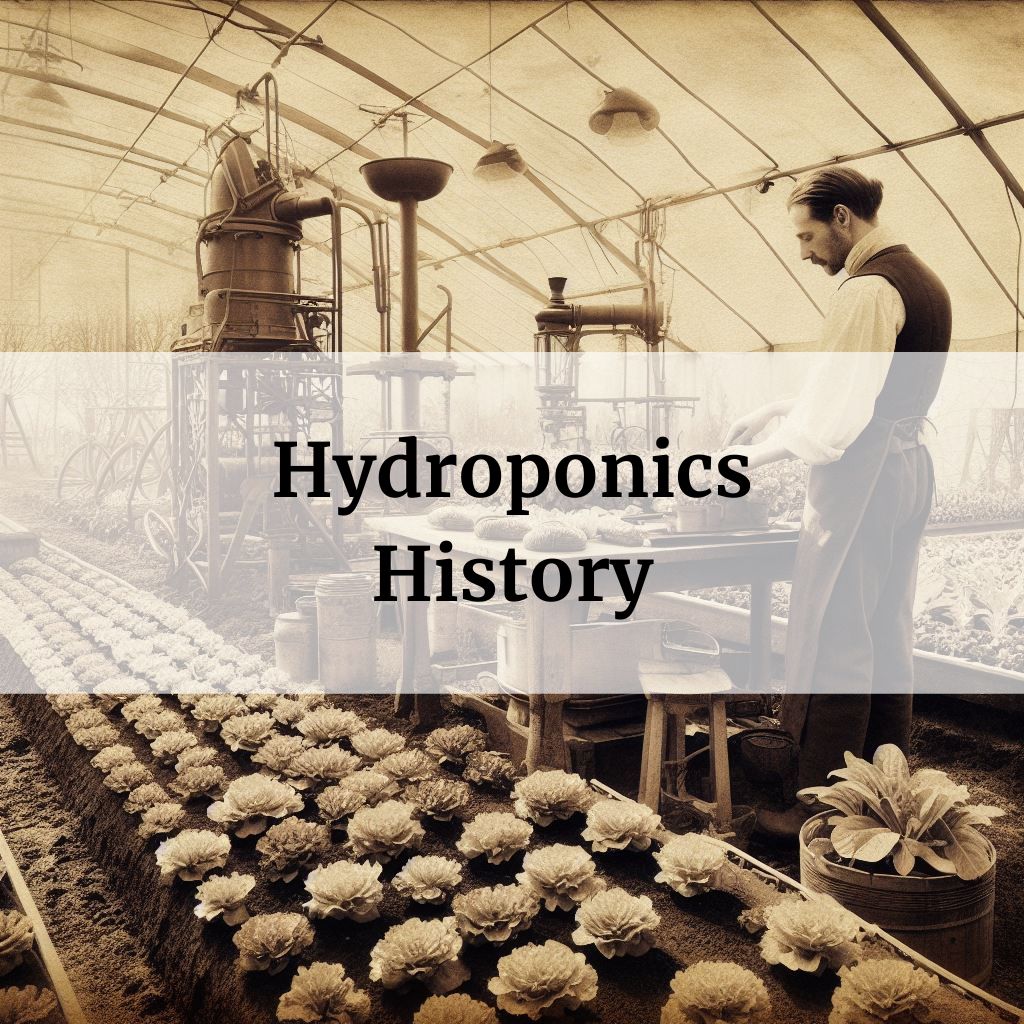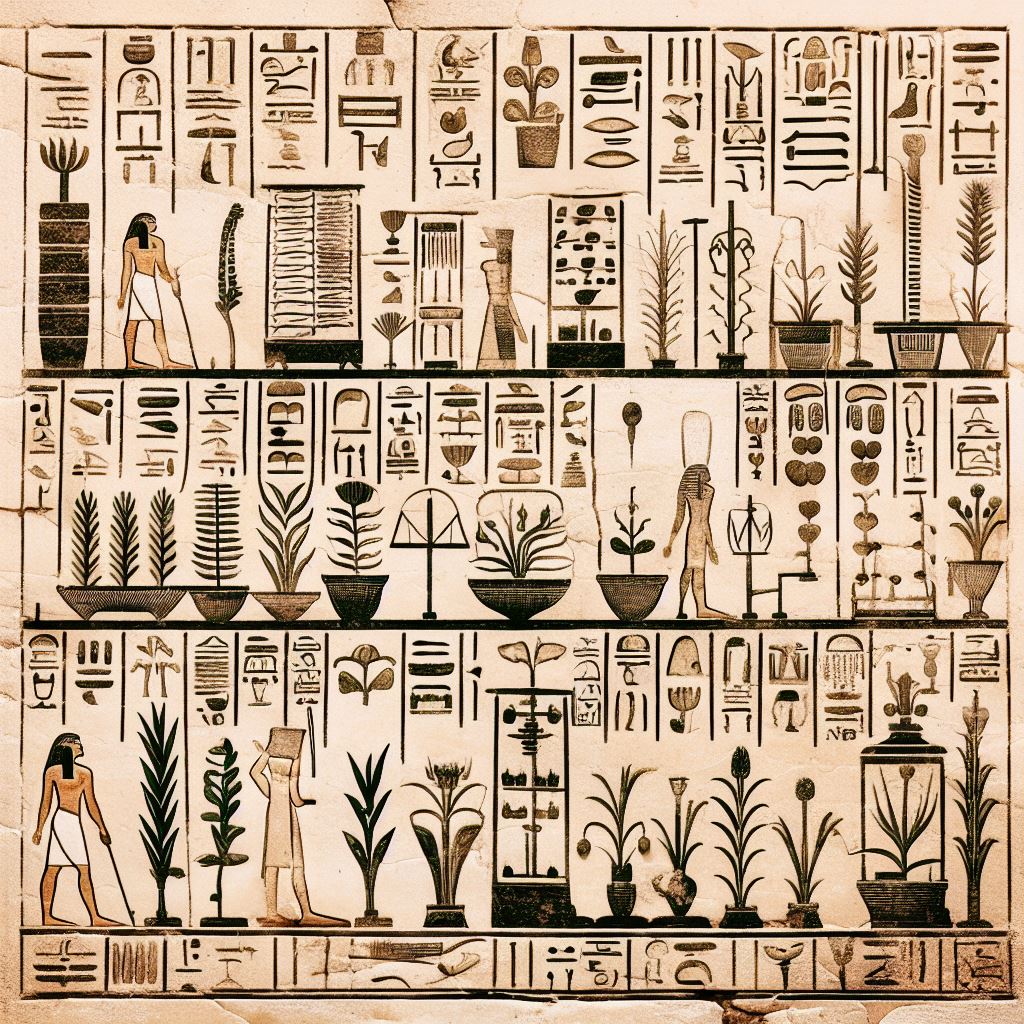
Hydroponics is a soilless method of growing plants using mineral nutrient solutions in a water solvent. It has a long and fascinating history, with origins dating back thousands of years. Today, it is used all over the world for commercial crop production and home gardening. In this article, we’ll explore the captivating history of hydroponics, from ancient Egypt to modern-day global adoption, and discuss its future potential.
In this article
Where Did Hydroponics Originate?
The earliest origins of hydroponics can be traced back to ancient civilizations in Egypt, China, and the Aztec empire.
Ancient Hydroponics Systems

- Around 1600 BC, hieroglyphics and pictorial representations from ancient Egypt suggest primitive hydroponic systems were used to grow plants along the Nile river.
- Chinese emperor Shen Nung experimented with hydroponics over 2,000 years ago using floating gardens to grow vegetables.
- The Aztecs developed floating gardens known as Chinampas between 1100-1400 AD in Valley of Mexico to grow crops on the marshy lake beds.
These early hydroponic systems demonstrate that ancient civilizations understood how plants could grow without soil if their roots had access to nutrient-rich water.
The Era of Modern Hydroponics Emerges
It wasn’t until the 17th century that hydroponics as we know it today started to take shape. In 1627, renowned British scientist Sir Francis Bacon conceptualized a nutrient-rich water solution that could stimulate plant growth.
In 1860, German botanists Julius Von Sachs and Wilhelm Knop published detailed research on growing plants in nutrient solutions alone. This laid the groundwork for future hydroponic development.
Where is Hydroponics Used in the World Today?
Initially, hydroponics was researched mainly in European countries like England, Germany, and Holland. But it has since expanded globally as a revolutionary way to grow food. Here are some of the key locations using hydroponics today:
Widespread Commercial Use
- The Netherlands – Massive hydroponic greenhouses are used to grow vegetables and flowers commercially year-round for domestic and export markets. The Netherlands has over 10,000 hectares dedicated to hydroponic greenhouse farming.
- Australia & New Zealand – With hot climates and scarce water, hydroponics is ideal. Australia has numerous large-scale hydroponic farms and greenhouses producing tomatoes, cucumbers, peppers, lettuce, herbs, and more.
- Middle East – Countries like Israel, UAE, and Saudi Arabia use hydroponics to grow produce in the desert by making maximum use of limited water. Israel is a hydroponics leader with advanced technology.
- North America – US and Canada have many large commercial hydroponic farms. Main crops include lettuce, tomatoes, peppers, cucumbers, berries, and herbs.
Home and Hobby Greenhouses
- UK & Europe – Hydroponic kits and home greenhouses are popular across UK and Europe for hobby gardeners growing vegetables, fruits, flowers.
- Asia – From Japan and Singapore to India, hydroponic gardening is gaining popularity among urban home gardeners with limited outdoor space.
- South America – Brazil, Peru, Argentina have a growing number of hobby hydroponic growers.
Who Uses Hydroponics?
Hydroponics is used by a diverse range of growers, from large commercial farms to urban home gardeners. Here are some of the key groups adopting hydroponic technology:
Commercial Growers
Large greenhouse farms use hydroponics to grow vegetables, fruits, herbs, and flowers on an industrial scale for commercial sales and export to retailers. With hydroponics, they can maximize yields and quality while minimizing water usage and land resources. Some major crops include tomatoes, peppers, cucumbers, lettuce, strawberries, and cannabis
The Netherlands, Spain, Australia, Mexico, and Canada have huge commercial hydroponic greenhouse farms. In the U.S., most commercial hydroponic farms are located in ideal climates like California, Arizona, Florida, Oregon, and New York.
Restaurants & Hotels
Hydroponic systems allow high-end restaurants and hotels to grow fresh ingredients like lettuce, tomatoes, herbs, and microgreens on-site for the ultimate farm-to-table dining experience. This produces super fresh, flavorful produce and herbs that chefs can harvest right before meals.
Luxury hotels like the Park Hyatt in New York and Waldorf Astoria in Beverly Hills have installed rooftop hydroponic farms. Restaurants across Europe and North America feature urban hydroponic farms for seasonal ingredients.
Home & Urban Gardeners
For hobby gardeners with limited outdoor space in cities, hydroponics offers an efficient way to grow vegetables, herbs, fruits, and flowers by maximizing vertical space. From balcony and patio systems to indoor hydroponic grow rooms, urban gardeners are turning to hydroponic
Europe and North America have seen a boom in home hydroponic kits and supplies as food security and local sourcing became more important during the pandemic. Asia and South America are also seeing a rise in urban hydroponic gardening.
Educators
Universities, high schools, and vocational programs use indoor hydroponic systems in classrooms and labs to teach students about innovative, eco-friendly planting techniques. Hands-on hydroponic education promotes STEM and agricultural skills
NASA also uses hydroponics to educate students on how plants grow in space. The European Space Agency has an education program called “AstroPlant” where students can set up a classroom hydroponic farm.
Researchers
In addition to NASA, academic researchers study hydroponics to improve the controlled environment agriculture. Research focuses on developing new hydroponic techniques and technologies to maximize crop yields, optimize nutrients, conserve resources like water, and grow food sustainably even in challenging climate.
Who Started Hydroponics?
While ancient civilizations originated primitive hydroponics, these key innovators helped transform it into the revolutionary growing method we know today:
William Frederick Gericke: The “Father of Modern Hydroponics”. In 1929, Gericke successfully grew tomato plants in mineral nutrient solutions at the University of California. He coined the term “hydroponics”.
Dennis R. Hoagland: In 1933, Hoagland partnered with Gericke and developed an optimal nutrient formula for hydroponic plant growth that became known as the Hoagland Solution. It is still used today.
Allen Cooper: The “Father of Commercial Hydroponics”. In the 1960s, Cooper created the Nutrient Film Technique (NFT), which enabled large-scale hydroponic farming. He built the first commercial hydroponic farm in 1969.
Who Invented Hydroponics As We Know it Today?

While hydroponic systems were experimented with for centuries, Dr. William Frederick Gericke is credited with taking concepts from the past and transforming hydroponics into the growing method we know today.
In 1929 at the University of California, Gericke successfully grew tomato plants in mineral nutrient solutions. He gave this soilless cultivation method the name “hydroponics” from the Latin words for water (“hydro”) and labor (“ponos”). Gericke’s work established the foundations for hydroponics going forward.
The Future of Hydroponics is Bright
With a long, evolving history and innovators who shaped it into a scientifically proven growing method, hydroponics has become a globally significant way to produce food.
Hydroponic adoption continues to increase worldwide, for applications ranging from commercial agriculture to home gardening. Technological improvements combined with rising environmental concerns will further the growth and development of hydroponic systems in the future.
This revolutionary soilless growing method is making agriculture more efficient, sustainable and productive to meet the food demands of our changing world. The future is bright for hydroponics.
Frequently asked questions
How long has hydroponics been around?
While primitive hydroponic systems were used thousands of years ago, modern hydroponics originated in the 1920s and 1930s through the pioneering work of William Gericke and Dennis Hoagland at the University of California.
What plants can be grown hydroponically?
Many vegetables, fruits, flowers, and herbs can be grown hydroponically including tomatoes, cucumbers, lettuce, spinach, peppers, strawberries, orchids, cannabis, basil, and more.
Why is hydroponics used globally?
The ability to grow plants in nutrient solutions instead of soil offers advantages like faster growth, higher yields, less water usage, control over nutrients, and sustainability. This makes hydroponics well-suited for many regions and applications.
Is hydroponics only used on large commercial farms?
No. While hydroponics enables large-scale greenhouse farming, it is also widely used by small urban farms, restaurants, schools, home gardeners, and hobbyists. Efficient hydroponic systems can be built at many scales.
What regions have the most hydroponic farming?
The Netherlands, Australia, Israel, Spain, and USA are leaders in large-scale commercial hydroponic farming. UK and Europe adopt more small-scale hydroponic systems for urban farms and home use. Overall, use is rising globally.







